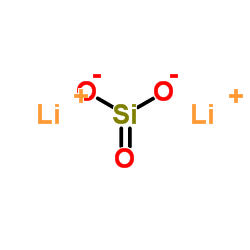硅酸锂, 99%,LITHIUM METASILICATE
产品编号:西域试剂-WR364772| CAS NO:10102-24-6| 分子式:Li2O3Si| 分子量:89.97
本网站销售的所有产品仅用于工业应用或者科学研究等非医疗目的,不可用于人类或动物的临床诊断或者治疗,非药用,非食用,
| 英文名称 | LITHIUM METASILICATE |
|---|---|
| CAS编号 | 10102-24-6 |
| 产品熔点 | 1204°C |
| 产品密度 | 2,52 g/cm3 |
| 精确质量 | 89.993675 |
| PSA | 63.19000 |
| 外观性状 | 固体;White to Almost white powder to crystal |
| 稳定性 | 溶于水及碱性溶液,不溶于醇及有机溶剂。与酸作用游离出凝胶。有自干性,溶液水分蒸发后,能生成一种不溶于水的干膜,具有水不可逆性。不溶于冷水,在沸水中分解。 |
| 储存条件 | 应贮存在通风阴凉的库房内。 |
相关文档
化学品安全说明书(MSDS)
下载MSDS质检证书(COA)
相关产品
| 风险声明 (欧洲) | R36/37/38 |
|---|---|
| 安全声明 (欧洲) | S26-S36/37/39 |
| 海关编码 | 2839900090 |
|
Section 1: Product Identification Chemical Name:Lithium metasilicate, 99% CAS Registry Number:10102-24-6 Formula:Li2SiO3 EINECS Number:233-270-5 Chemical Family:metal silicate Synonym:Silicic acid dilithium salt, Lithium silicate
Section 2: Composition and Information on Ingredients IngredientCAS NumberPercentACGIH (TWA)OSHA (PEL) Title Compound10102-24-6100%no datano data Section 3: Hazards Identification Causes severe irritation to eyes and skin. Lithium salts are toxic to the central nervous system and on Emergency Overview: repeated ingestion may damage kidneys and act as a teratogen Primary Routes of Exposure:Ingestion, inhalation, skin and eyes Eye Contact:Causes severe irritation of the eyes resulting in redness and watering. Skin Contact:Prolonged contact with moist skin causes irritation. Inhalation:May cause difficulty in breathing and irritate the mucous membranes and respiratory tract. Ingestion:May cause ulceration of esophagus and stomach. May be harmful if swallowed. Lithium salts are toxic to the central nervous system. Irritation will occur at all Acute Health Affects: points of bodily contact. Prolonged inhalation of silica dust can produce silicosis with impairment of the cardiopulmonary system. Chronic Health Affects: Lithium may cause kidney damage and act as a teratogen. NTP:No IARC:No OSHA:No SECTION 4: First Aid Measures Immediately flush the eyes with copious amounts of water for at least 10-15 minutes. A victim may need Eye Exposure: assistance in keeping their eye lids open. Get immediate medical attention. Wash the affected area with water. Remove contaminated clothes if necessary. Seek medical assistance if Skin Exposure: irritation persists. Remove the victim to fresh air. Closely monitor the victim for signs of respiratory problems, such as difficulty Inhalation: in breathing, coughing, wheezing, or pain. In such cases seek immediate medical assistance. Seek medical attention immediately. Keep the victim calm. Give the victim water (only if conscious). Induce Ingestion: vomiting only if directed by medical personnel. SECTION 5: Fire Fighting Measures Flash Point:not applicable Autoignition Temperature:none Explosion Limits:none Extinguishing Medium:none required If involved in a fire, fire fighters should be equipped with a NIOSH approved positive pressure self-contained Special Fire Fighting Procedures: breathing apparatus and full protective clothing. Hazardous Combustion andNone Decomposion Products: Unusual Fire or Explosion Hazards: No unusual fire or explosion hazards. SECTION 6: Accidental Release Measures Spill and Leak Procedures:Small spills can be mixed with powdered sodium carbonate or ground limestone and swept up. SECTION 7: Handling and Storage Handling and Storage:Store material in a tightly sealed bottle away from moisture. SECTION 8: Exposure Controls and Personal Protection Eye Protection:Always wear approved safety glasses when handling a chemical substance in the laboratory. Skin Protection:Wear appropriate chemical resistant gloves and protective clothing. Ventilation:If possible, handle the material in an efficient fume hood. In the absence of adequate ventilation a respirator should be worn. The use of a respiratory requires a Respirator: Respirator Protection Program to be in compliance with 29 CFR 1910.134. Ventilation:If possible, handle the material in an efficient fume hood. Additional Protection:No additional protection required. SECTION 9: Physical and Chemical Properties Color and Form:white pwdr. Molecular Weight:89.94 Melting Point:1201° Boiling Point:no data Vapor Pressure:no data Specific Gravity:2.52 Odor:none Solubility in Water:soluble SECTION 10: Stability and Reactivity Stability:air and moisture stable Hazardous Polymerization:no hazardous polymerization Conditions to Avoid:none Incompatibility:none Decomposition Products:none SECTION 11: Toxicological Information RTECS Data:No information available in the RTECS files. Carcinogenic Effects:no data Mutagenic Effects:no data Tetratogenic Effects:no data SECTION 12: Ecological Information Ecological Information:No information available SECTION 13: Disposal Considerations Disposal:Dispose of according to local, state and federal regulations. SECTION 14: Transportation Shipping Name (CFR):Non-hazardous Hazard Class (CFR):NA Additional Hazard Class (CFR):NA Packaging Group (CFR):NA UN ID Number (CFR):NA Shipping Name (IATA):Non-hazardous Hazard Class (IATA):NA Additional Hazard Class (IATA):NA Packaging Group (IATA):NA UN ID Number (IATA):NA SECTION 15: Regulatory Information TSCA:Listed in the TSCA inventory. SARA (Title 313):Title compound not listed Second Ingredient:none SECTION 16 - ADDITIONAL INFORMATION N/A |








 浙公网安备 33010802013016号
浙公网安备 33010802013016号